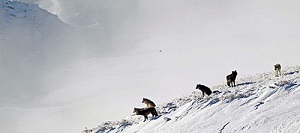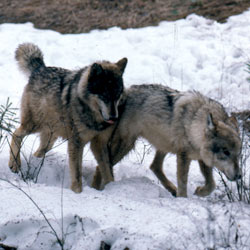Wolves can be found throughout Yellowstone and Grand Teton National Parks. Their reintroduction into Yellowstone in 1995 and 1996 was an amazing conservation success story. Within a few years wolves were being spotted in the Jackson Hole valley. The route they traveled to get here is still unknown, but it's possible that they went through the John D. Rockefeller, Jr. Memorial Parkway!

Greater Yellowstone Science Photo
Wolves are highly social animals that live in packs. Wolf packs typically consist of a breeding pair (the alpha male and alpha female) and their offspring. Packs may also include a breeding pair, siblings, and subordinate wolves. Pack size ranges from three to over 20 individuals, and territory size fluctuates depending on pack size and prey availability. Wolf litters in Wyoming average five pups; some packs produce two litters a year. All pack members feed and rear the young. Wolves howl to attract mates, locate pack members and defend their territories against invading wolves or packs.
The first pack in Grand Teton was the Teton Pack, which formed when a female known as 24F - whose father was one of the original wolves transplanted from Canada - arrived and mated with 133M. These two wolves denned and produced five black pups in 1999 - the first wolf reproduction in Grand Teton in over 70 years. The offspring from this pair and other immigrants from Yellowstone National Park eventually helped repopulate Jackson Hole.

NPS Photo
Biologists radio-collar wolves to track their locations and identify if they're successful in breeding and establishing packs. Biologists assign numbers to wolves in the order that they were collared starting from the beginning of the reintroduction project. For example, 24F was a female that was the 24th wolf collared in the park. Not every wolf is collared now, but biologists continue to use collars to learn more about wolf ecology.
Many scientists consider the restoration of the wolf to Yellowstone to be the restoration of ecological completeness in the Greater Yellowstone Ecosystem. This region now contains every large wild mammal, predator or prey, that inhabited it when Europeans first arrived in North America. But the wolf is only one factor-albeit restored-in the extremely complex and dynamic community of wild Yellowstone. For the visitor, this community's complexity has been highlighted primarily through the large predators and their prey species. This ecological "suite" of species provides a rare display of the dramatic pre- European conditions of wildlife in North America.

NPS Photo
While some people delight in the chance to experience the new completeness of the Yellowstone ecosystem, others are alarmed and angered by the changes. But with so few places remaining on Earth where we can preserve and study such ecological completeness, there seems little doubt about the extraordinary educational, scientific, and even spiritual values of such a wild community.
Sources:
Greater Yellowstone Coalition, Jackson Hole Conservation Alliance, National Parks Conservation Association, Sierra Club, and Wyoming Outdoor Council. http://www.jhalliance.org/Library/Alerts/WolvesInTetons.8-08.pdf
Yellowstone National Park. 2012. Yellowstone Resources and Issues Handbook: 2012. Yellowstone National Park, WY.
